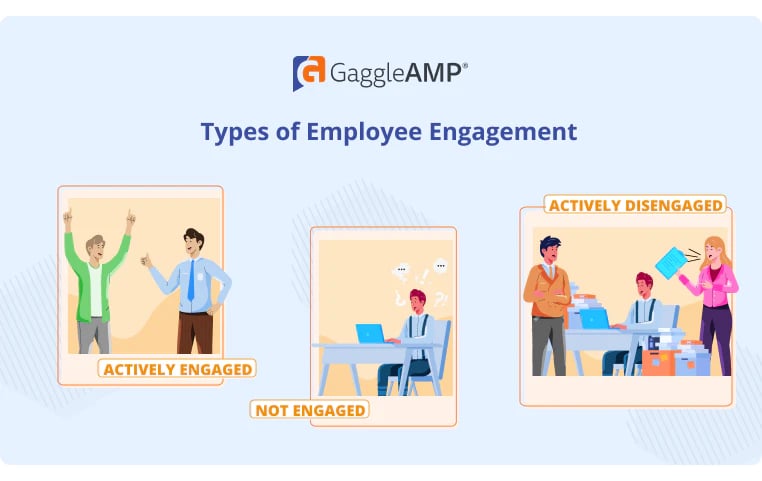Employee engagement matters. Companies with a highly engaged workforce have a distinct advantage. They tend to have less turnover, more productivity, and higher profits. However, according to a Gallup employee engagement poll, only 15% of the global workforce (15%) can be classified as “engaged.”
The need for companies to invest in employee engagement is apparent. In order to create the right engagement strategies for teams, managers need to understand how employee engagement has evolved over the years.
To best understand the evolution of employee engagement, we’re going to define what it is, how it’s evolved, and where it’s headed. Up first: what is employee engagement?
What Is Employee Engagement?
Employee engagement is defined as the connection an employee has to their employer and the level of commitment that employee has to their work and workplace.
The level of employee engagement can be linked to a business’ mission, values, and work culture. When these things strike a positive chord with employees, employees are more likely to feel and express genuine commitment toward their workplace, resulting in higher engagement. When employees are highly engaged, there are several benefits.
Benefits of Employee Engagement
By investing in employee engagement, businesses can help boost levels of motivation, productivity, and satisfaction among employees. This, in turn, benefits the company. The benefits of employee engagement can range from reduced absences and turnover to higher productivity and profits for a business.
So, what are the types of employee engagement? Let’s take a look.
What Are the Types of Employee Engagement?
There are three types of employee engagement: actively engaged, not engaged, and actively disengaged.

Actively Engaged
Actively engaged employees are the gold standard when it comes to employee engagement. Here’s why: actively engaged employees take initiative, view themselves as part of a team, and carve out opportunities to collaborate with others. Since they are so passionate and committed to their work, it’s unlikely they will want to leave their jobs.
When employees take pride in their work and feel a strong sense of connection with their company, they are also motivated to work harder and invest in the growth and development of the company. They will believe strongly in the company’s mission and success and make sure to do their part to support it.
Not Engaged
Not engaged employees do their job quickly and efficiently without making an effort to go above and beyond in the workplace. According to Gallup, the majority of employees in a company are not engaged.
Not engaged employees view their job as something they have to do to earn a living. They don’t have a sense of purpose, or a special attachment towards their work and workplace. They may also be slightly dissatisfied with the work environment or the way the company operates.
Since they are not actively disengaged or unhappy in the company, a little push in the right direction is all it might take to turn them into actively engaged employees.
Actively Disengaged
Actively disengaged employees tend to have strong negative feelings about their work or workplace.
These employees will not participate in beneficial employee engagement activities that are beyond the scope of their job description. Whether the reason is a lack of motivation or a refusal to invest time and energy in the company, it doesn’t matter. Ultimately, their actions (or lack thereof) can actively harm the company.
This harm can be in the form of lower productivity and morale in the team. The employee’s discontent may also lead them to search for other jobs, which will subsequently affect company retention.
Actively disengaged employees may only form a small part of the company, but their influence on their fellow employees should not be underestimated.
Managers need to know which of these categories their employees fall under. Knowing whether an employee is actively engaged, not engaged, or actively disengaged can help a manager determine the next steps to remedy the situation. Ultimately, the goal is to foster a workplace culture that most employees wish to actively participate in.
Understanding how employee engagement has evolved over the years is the next step in your journey to building such a culture.
How Has Employee Engagement Evolved?
Before there was employee engagement, there was job satisfaction. Going back to the 1930s, the employee-company relationship was initially understood as broadly disconnected and limited to an employee’s satisfaction with their job. A company could have a highly satisfied employee, but job satisfaction did not automatically translate into any kind of active engagement within the company.
It wasn’t until 1990 that the idea of employee engagement would be introduced.
Kahn Introduces the Concept of Employee Engagement
In the 1990s, William A. Kahn first introduced the concept of employee engagement in his article, “Psychological Conditions of Personal Engagement and Disengagement at Work.”

Since Kahn, there have been several different approaches to defining the employee engagement theory. There has been a shift from focusing on job satisfaction to measuring an employee’s commitment to their job. Over time, the connection between employee behavior and business outcomes, including profit, was established.
Companies Realize the Importance of Employee Engagement
In the 2000s, companies like Campbell’s Soup started to realize the importance of employee engagement. During this time, companies noticed a sharp decrease in their retention rates. This massive drop was attributed to the shift towards a service economy, which encouraged flexibility.
Increased market competition was another factor that pushed companies to take their turnover rates more seriously. As a result, companies were incentivized to devote time and energy to ensure that their employees’ were actively participating in company activities. More importantly, companies wanted to ensure that their employees’ attitudes toward the workplace were positive.
Concerned with business metrics such as absenteeism, sales, and customer service, companies continued to prioritize employee engagement and invested resources into improving it.
Shift in Employee Engagement Responsibility
There has also been a shift in who is responsible for overseeing employee engagement. What was once a human resource responsibility, now other departments, managers, and those in leadership positions need to play a part, too. Furthermore, they need to cultivate employee engagement and consider how to engage leaders in employee engagement, increase remote employee engagement, and explore new employee engagement ideas.
Where Is Employee Engagement Headed?
Today, the research and tools to increase employee engagement and boost business outcomes are readily available to companies. The challenge lies in committing to employee engagement and making consistent active efforts to keep your employees motivated.
By leveraging employee networks, companies can further their reach organically as actively engaged employees make for stellar spokespeople for their companies. Genuine employee advocacy is one way to sustain high levels of employee engagement over a long period. Incentivizing employees to participate in one-click advocacy activities helps businesses strengthen and sustain the link between employee engagement and positive business outcomes.
Invest in your employees and your business simultaneously by booking a call with GaggleAMP today.







